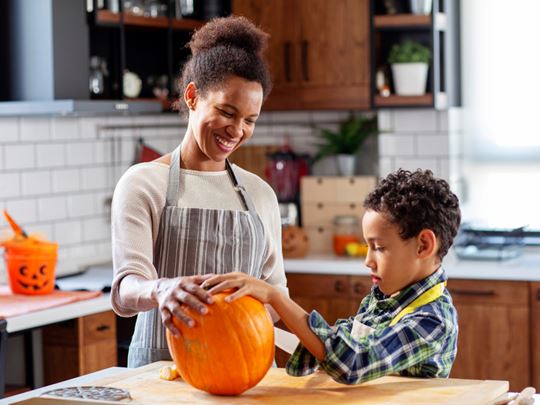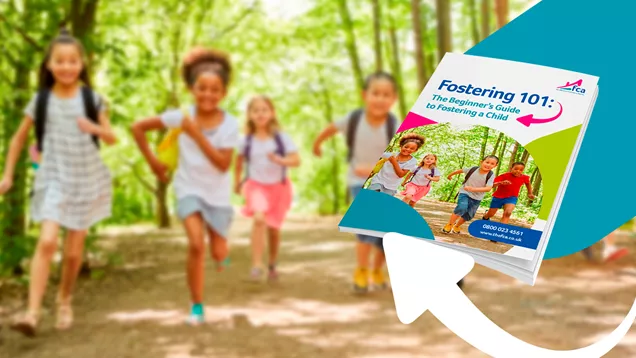Halloween is now a spooky staple in the UK, with more and more people participating in the festivities each year. From carving creepy faces into pumpkins to trick-or-treating around your neighbourhood, it’s a chance for children to dress up and indulge in a fantasy world of monsters, witches and ghosts.
While trick-or-treating is the most common Halloween tradition, it doesn’t always appeal to everyone. The majority of children in care will have suffered some form of trauma, so it’s important to protect their newfound sense of safety they have with you. It’s possible your foster child might be feeling uneasy about the prospect of trick-or-treating due to their difficult pasts. Perhaps they’re afraid of the dark or the idea of approaching unknown houses is triggering their anxiety. If this is the case, fear not! There are plenty of other fun things to do with your foster child this Halloween.
Check out our favourite ideas for how to make this scary season a great time for your foster children.

6 Alternative Activities To Trick-or-treating
Pumpkin carving
This is a great, inclusive activity for the whole family to enjoy. Everybody has to draw a freaky or funny face onto a pumpkin which is then carved out – once you’ve scooped the insides of the pumpkin out, of course. Place a candle inside the pumpkin and watch as the faces come to life! Jack-o-lanterns are also a handy signal to let trick-or-treaters know they’re welcome to knock on your door. If your foster child is comfortable with this, pop your pumpkins on the windowsill or on the doorstep and get a bowl of sweets ready to hand out on 31 October.
For a less frightening alternative, you could simply decorate the outside of your pumpkins with things like sequins, dry pasta shapes, feathers and glitter. Halloween might celebrate all things horror, but it’s cool to break the mould and be different too.
Just be careful to assist teenagers when using sharp knives, and don’t let little ones try to carve their own pumpkin.

Bloodcurdling bakes
A big part of Halloween is all the sweet treats that are floating around. Rather than buy a bag of generic candy from the shops, use this opportunity to bond with your foster child in the kitchen. You could make:
- creepy cookies shaped like spiders, bats and cobwebs
- a jelly graveyard where you put lychee ‘eyeballs’ and strawberry lace ‘veins’ in the jelly mix
- monster doughnuts with a raspberry jam mouth, chocolate button eyes and fizzy fang teeth
- a terrifying trifle, which is essentially a DIY dessert. Let your foster child add an assortment of shop-bought treats, fruit ice cream and cake to a big bowl, topped off with blood red strawberry sauce of course!
Movie marathon night
As a child, there’s something special about staying up late once in a while, and it’s made even better if there’s a ‘midnight feast’ involved. You don’t have to stay up till midnight though to recreate that feeling.
Light some candles, bring the duvets down from the bedrooms and turn your lounge into a cosy theatre any time of day or night. There are plenty of child-friendly Halloween films too, with Hocus Pocus and Harry Potter being firm favourites in many households. Snuggle down with a pizza delivery and popcorn and enjoy a fun film session together.
Potion making
This is a great sensory play activity to help young children and those with autism learn new skills and improve cognitive development. Sensory play activities use different textures, sounds and smells to help your foster child process sensory information in a fun and engaging way – and this witches’ brew is the perfect Halloween activity! Fill a cauldron with water, add some green food colouring and then let your foster child mix in different items to create their own (inedible) potion. From cooked spaghetti ‘veins’, jelly ‘brains’ and lychee ‘eyeballs’ to crunchy leaves, sparkly sequins and ‘monster poo’ mud, the options are truly endless.
Glow in the dark treasure hunt
This game is sure to excite children and teenagers who aren’t afraid of the dark. All you need are some glow sticks and a variety of different chocolate bars, bags of crisps or other snacks your foster children enjoy. Hide the treats around your house, placing a glow stick next to each one. When it’s dark and the lights are off, the treasure hunt begins! It’s a cool alternative to trick-or-treating where your foster kids have to hunt for their own treats but from the comfort and safety of your home. If you have multiple children in your care, you can turn it into a friendly competition with a prize for who collects the most treasure.

DIY dress up
Dressing up is a big part of Halloween. From wicked witches to devilish Draculas, it’s always fun to create a costume and get into character. Even if you’re not planning on trick-or-treating, that doesn’t mean to say you can’t join in with the tradition of dressing up. You could use Halloween as a chance to get crafty with household items. Here are some fun dressing up games to enjoy this year:
- Mummy wrapping. It’s a race against the clock as your foster child has just 60 seconds to turn you into a mummy using toilet roll! Get the whole family involved for an epic battle.
- Easy witches. Go foraging in the garden or local park to see if you can find any long branches that have fallen off the tree to be your broom handle. Then, collect some smaller twigs to tie around the end for the broom bristles. Cut a hole in the top of the bin bag for your witches’ cloak and there you have it! A costume that’s simple, effective and easy on the purse strings too.
- Angel or devil wings. If you’ve got some spare wire coat hangers lying around, enhance them with some decorations to turn them into angel or devil wings. Using sticky tape, tie the hooked parts of two wire coat hangers together. This will be where your foster child feeds their arms through, similar to a backpack. Repeat with another two hangers to create the wings and attach together. Assisting them, glue feathers, tissue paper and leaves to the hangers acting as wings and let your foster child transform into their own fantasy angel or devil.

Join the FCA family
With over 25 years’ experience of foster care, we know what it takes to transform a child’s life. It’s not always easy, but with FCA, you’re never on your own. If you’re currently fostering a child but would like to know what more you could get with FCA, please get in touch today. It could be the best decision you make.
Not sure if you meet all the requirements? Give us a call on 0800 023 4561 and we can answer any questions you have.
Foster Care Requirements
- Be over 21 years old (there’s no upper age limit)
- Have a spare bedroom but you don’t need to own your own house
- Be a British Citizen or have indefinite leave to remain
- Generally, you’ll need to be able to foster full-time, but there are a few exceptions
- Plenty of patience, energy, resilience and commitment

Are you thinking of fostering?
Download the FCA’s complete beginner’s guide to fostering a child. Find out more on how to foster a child and the process involved.




